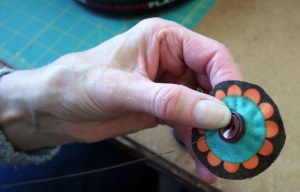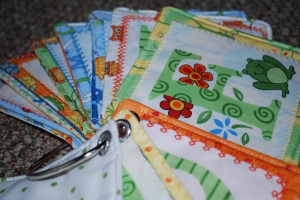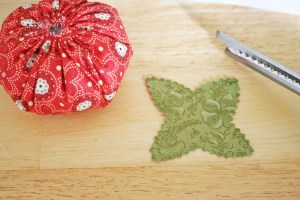A small scrap of wool felt in white and pink.
White, pink and dark brown 6 strand embroidery floss to match.
Good quality polyester toy fill.
A small piece of fusible web.
Strong polyester sewing thread.
Stuffing tools (I like to use a wooden skewer and paint brush).
Optional: Yo-Yo (Suffolk Puff) maker to make 3/4″ yo-yos.

Download the Printer Friendly PDF at the bottom of the post. Print your templates and cut out all pattern pieces on the line.
Select 9 of your fabric strips to create your “Oopsie.” The 9th fabric needs to have a lot of contrast with the other 8 to create suckers (yo-yo’s) that really stand out. I chose to use the white spot on top of solid color prints for this purpose. Four of your body strips will create the body and the other four will create the 8 legs.
 Once you are happy with your fabric selection, place the folded strips (other than your 9th strip) on your cutting board and trim off the selvage and fold. You only need 1/2 of each strip for this project.
Once you are happy with your fabric selection, place the folded strips (other than your 9th strip) on your cutting board and trim off the selvage and fold. You only need 1/2 of each strip for this project.
 Take the four strips that are intended for the body, and using a 1/4″ seam allowance, sew the strips together in order.
Take the four strips that are intended for the body, and using a 1/4″ seam allowance, sew the strips together in order.

Until you have a pieced panel that looks like the following.

Fold your fabric panel in half, right sides together, so that all of the seams meet evenly. Now pin your body template to one half of the panel and cut the shape out.

Repeat with the second half of your folded panel so that you have four body pieces as per the following image.

Take two of your body pieces and sew them together along one side edge only, right sides together. I recommend that you always use polyester thread and a small stitch (approx 1 – 1 1/2) on your sewing machine for extra strength of seams. Repeat with your remaining two body pieces.

Now open out your body front and body back pieces. Place them on top of each other, right sides together, ensuring that all seams meet. Pin in place.

Sew the body front and body back together along both side edges, however this time please leave a 1 1/2″ gap in one side edge for turning and stuffing. Turn right side out and put aside for now.

Take one of your leg fabric strips and fold it evenly in half, right sides together. Trace the leg template twice onto this folded strip. This will be a tight fit but make sure there is some seam allowance at both raw edges.

Please ensure that you transfer the gap markings and pin the fabric together to secure. Do not cut out as these legs will be sewn on the marked line.

Using a small stitch on your sewing machine sew the legs together along the marked lines, leaving the gaps as marked. Cut the legs out approx 1/8″ outside the sewn line. Clip curves.

Repeat with your remaining 3 leg strips. Turn all of your legs right side out.

Take one of your legs and position the end opening so that the seams are now on top of each other. If desired please tack these edges together.

Keeping the leg opening in this position, pin or tack the leg to the bottom raw edge of your body. Please ensure that the top seam of the leg (without turning gap) is facing the right side of the body.

Alternating the print, pin all of the legs to your body in the same manner. 2 legs should fit side by side within each of the 4 body panels.

Using your sewing machine, tack all of the legs onto the body approx 1/8″ outside the raw edges. Now turn your body inside out. Position the leg inside the body evenly so that the top edges are flat.

Take two lengths of one of your body strips (no need to cut accurately as long as they are minimum 4″ in length), sew together along the length and press. Pin your body base template onto this and cut out the circle.

Fold the circle in half (seams together) and finger press so that you can easily see the quarter points.

Place your base right side down over the body opening and match one quarter point up with one of your 4 body seams. Pin in place and than continue this with each quarter.

Now also pin in place between each quarter. At this point I recommend tacking but this is optional.

Using a small stitch on your sewing machine, sew the base into the body. This stitching will secure the legs between the body and base seams. It is a good idea to sew slowly and rotate the body as you go to avoid puckering.

You will now have your completed body looking something like this.

Using a turning tool, turn Oopsie right side out through the gap in the body.

Stuff Oopsie’s body firmly with good quality toy fill. If you want to create a great circular shape then it is a necessity to stuff very firmly. If you have used polyester thread and small machine stitches then do not be fearful to keep stuffing until it will take no more.

Sinking your knots, ladder stitch the opening closed with 2 strands of polyester thread (if you are unsure of how to ladder stitch and sink knots then please visit my blog and check out the “Tips & Tricks Tuesday Tutorials”). You may want to stuff a little more as you sew to avoid a dimple in Oopsie.


Turn Oopise upside down and then start to stuff the legs firmly, using the gap in the bottom of the leg.


Once all the legs are stuffed sufficiently, ladder stitch the openings closed.

Iron some fusible web to your scraps of white and pink wool felt. Trace the eye template twice to the paper side of your white wool felt and trace your cheek template twice to the paper side of your pink wool felt.

Cut the shapes out on the traced lines, peel the backing paper away from the fusible web, and position the eyes and cheeks onto Oopsie. Iron into place. I recommend that you use a medium iron or cover the shapes with fabric when ironing to avoid the felt melting.

Using 2 stands of white embroidery floss, blanket stitch the eyes into place.

Mark the mouth circle onto the face and then using the same white floss, satin stitch the mouth in place.

Mark the pupil positions and then create the pupil with a french/colonial knot using 6 strand brown embroidery floss.

Blanket stitch the cheeks in place with 2 stands of pink embroidery floss and then backstitch around your mouth with the same thread.

Using a yo-yo (Suffolk Puff) maker or by hand (please look up a tutorial if unsure), create 12 x 3/4″ yo-yos out of your 9th fabric strip.

Using sewing pins, try different arrangements with four of the yo-yo’s on Oopsie’s body until you are pleased.

Also pin a yo-yo onto each of Oopsie’s tentacles.

Using 2 stands of polyester thread, ladder stitch all of the yo-yos into place on Oopsie.

And voila! You have your very own Oopsie to love!























































































































































































































































